About the author: Daniel Lee is one of the co-designers of Arachnoir, which is his first published game (in Print-and-Play format). As of this writing he has released one other game, Turbo Sleuth (published under Wizkids), as well as the physical box version of Arachnoir.
“Stalk the City. Corner your Prey. Tighten the Web …”
With these words the players, taking on the role of spider private investigators, begin the hunt for bugs infesting the city of Basin Quarter. Welcome to Arachnoir, a game close to my heart, not just because it is my debut game, but also because of its unusual theme and mechanics that tickle the imagination and rewards both careful planning and opportunistic snap judgments in equal measure.
As a relative newcomer in the field of board game design, I have experienced many eye-opening lessons through Arachnoir’s development journey. In this blog entry, I’ll be sharing 8 of the most important lessons that I’ve learnt through this process.
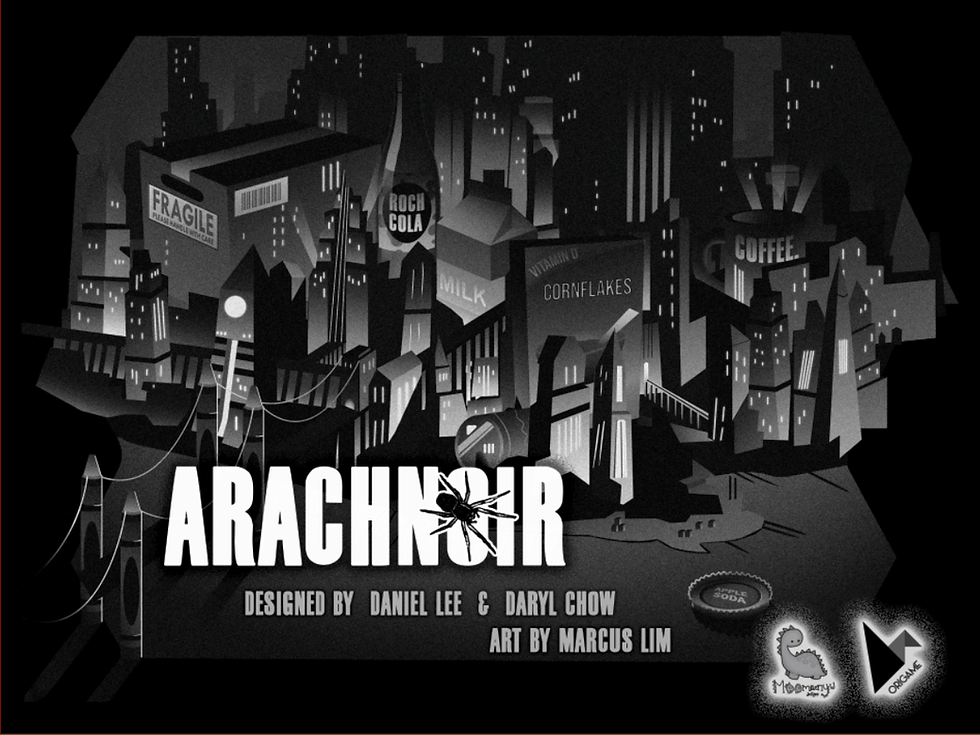
Lesson #1: Creativity does not exist in a vacuum
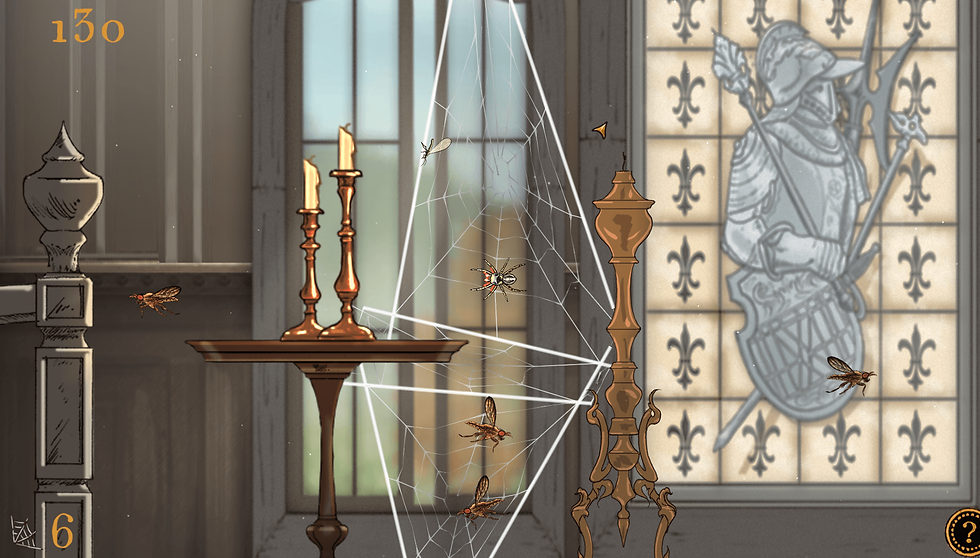
It is often easy to fall prey to the notion that creative inspiration can be born straight out of the blue, being a 100% original idea. The reality is that sitting around all day trying to squeeze my creative juices dry more often than not just results in wasted time. Creativity does not exist in a vacuum, and is usually built on something that already exists. A more reliable way of exercising the creative muscle is to take existing ideas and spinning them together in a way that is fresh and interesting.
Arachnoir was inspired by two ideas, the first of which is the digital game “Spider: Rite of the Shrouded Moon” (more on the second idea in Lesson #3). In that game, players take on the role of a spider, scuttling around in geometric patterns and strategically laying webs, with the ultimate aim of catching the myriad bugs that populate the game maps. Even though I had played this game many years ago, it left such a strong impression on me that even back then I was thinking, “how can I translate this into a functional board game?”.
Lesson #2: Give your ideas time to incubate
The key problem back then was that my knowledge of game mechanics was limited. I knew the game genre would be area-control and, being more of an abstract board gamer, the traditional solution to marking changes on the board was to plonk in little wooden pieces to denote borders, resources and influence. In Arachnoir’s case, this would have resulted in an absolutely huge pool of wooden pieces to make it work, and I was not willing to go down that path.
The answer eventually came in the form of roll-and-write games, a genre of games that has come to prominence in recent years. Using an erasable marker to draw webs on a game board was the key to replicating the same web-forming gameplay in a clean and efficient manner. Even then, I had not considered using it for Arachnoir, being initially only familiar with fast and small roll-and-write games like Ganz Schön Clever. It was only later in the trend when I encountered heavier Euro-style games like Florenza that I realized the potential of using erasable ink to code huge amounts of information into a game board that went beyond just filling in numbers and checkboxes.
Give your ideas time to incubate, and keep moving on in the learning process. Don’t write off an idea for a game, theme or mechanic just because you can’t make it work yet.
Sometimes, like Arachnoir, revisiting it at a later date when armed with more experience and ideas is the key to making it work.
Lesson #3: Indulge your whims from time to time

The second inspiration for Arachnoir came from my wife, Anne Marie, who had suggested I design a roll-and-write game based on gerrymandering. The original idea was to have square grid spaces where different coloured dots, representing voters, would be slowly filled in by the players, while lines were being drawn to group the squares into closed clusters. Early into the design process, I figured that having a way to limit line placement was crucial for the game to be strategic, and a moving piece on the board in the form of a campaign van was introduced. Dots and Lines could only be placed in the vicinity of the campaign van. This combination of a moving piece with a roll-and-write board was a key moment in the design process as I had not seen other games doing so at that time, and felt that it was pretty novel. In the end though, the gerrymandering game was functional, but didn’t have enough of a “hook” to make it truly fun.
It was around this time that I came across the adorable little Daiso spiders being sold in preparation for Halloween. Playing around with the spiders, I realized that they could fulfill the role of the campaign van. The lines became threads, clusters became webs with which to catch flies, and the dots became flies that slowly appeared throughout the game. And so, through having a bit of fun with a little toy spider, the first prototype of Arachnoir was born.
Lesson #4: Theme informs the Mechanics, Mechanics support the Theme
From a very early point in my journey into the board game design process I was introduced to a big debate: should theme come first, or mechanics? For a rather long time I grappled with this question, until slowly the revelation dawned upon me that it really does not matter. And here’s why.
Creativity does not need to be stifled by artificial notions of what should come first.
As I’d mentioned earlier, the creative process is often done through a combination of two or more things in a fresh way. It really does not matter which came first, as long as they both go into the mix. Feel free to be inspired by a theme or a mechanic you’re encountered. Try putting them together in your head (or a prototype, if you’re eager enough!) and roll with it to see comes out.
I’ve also come to realize that the design process is iterative in nature. No matter where you started in the game design process, be it theme or mechanic, you will find yourself constantly revisiting both as your game evolves. A game’s theme should inform you of the mechanics, that is, what mechanics fit naturally into the theme, or what can be added to an existing prototype. Is the game about spiders? How about mechanics that involve placing webs and competing to catch bugs? The mechanics in turn should support your theme. Catching bigger bugs gives you more food? Players should be rewarded with extra moves for catching those bugs then. When theme and mechanics go hand in hand like that, it all just “clicks” in players’ heads and the gameplay becomes much smoother.
Lesson #5: Making the game fun is the top priority
A caveat – even though mechanics and theme work together, again don’t be constrained by this as if it is a hard rule. You can always break it (carefully) in the name of fun. In Arachnoir’s case, we settled on the theme of 'Noir' because the first version was a Print-and-Play, and we wanted it to go well on black and white printers. Totally unrelated to spiders, but fun as an artistic style (to which our artist Marcus Lim did an amazing job). Mechanically, we added bonus objectives to compete over as well as tightened the restrictions on how bugs had to be caught, all to make the game more fun. And that is the ultimate objective of any board game design process – to make the game more fun.
Similar to Spider: Rite of the Shrouded Moon, we also took some artistic license with the spider, giving it a range of prowling, webbing and movement behaviour that isn’t necessarily accurate. Orb weavers for example, wouldn’t spin webs like the ones in Arachnoir, while also running all around the map. Jumping spiders would certainly run all around, but they don’t leave big webs behind. Sometimes it is necessary to bend the rules a bit in the name of fun.
When I shifted the game from a traditional square grid into a triangular one, one of the problems I learnt early in the playtesting sessions is that not everyone can visualise triangular shapes easily, leading to mistakes and increased mental burden. Some players actually get on fine with a certain group of shapes and struggle with another, while some players experience the exact opposite.
In the end, we came up with the solution of printing shape reference cards for everyone, so that they could hold it over the board and rotate it to visualise the shape.
Going the extra step to reducing a player’s mental burden will also result in more fun!
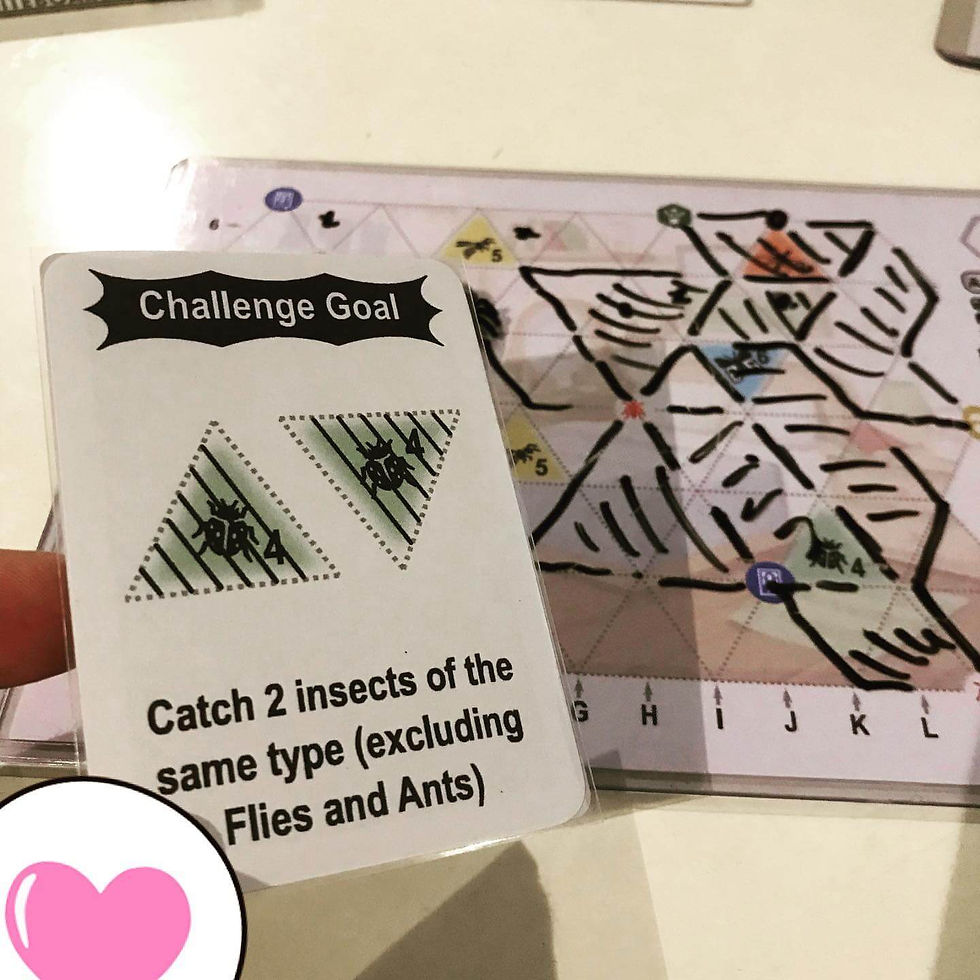
Lesson #6: Familiar but Fresh
The other big change from the original gerrymandering concept was the shift from a traditional square grid into a triangular one, sort of like the isometric graph paper we used to use in Design and Technology classes. Aesthetically, the triangular nature of the grid made perfect sense in Arachnoir, with webs forming at sharp angles, long ungainly swathes, and the especially satisfying hexagon. While the shift brought with it some new problems (such as some players having difficulty in visualising certain shapes), it also brought with it many benefits.
The greatest benefit I think, is that the triangular grid brings something familiar, yet fresh to the table. Arachnoir is at its core a puzzle game, with players trying to fit line combinations onto the board to meet their immediate objectives, as well as progress towards their end goals. It evokes the same satisfaction that you get when sliding Tetris blocks snugly into place to complete a line.
In Arachnoir, this goes even further as every line added moves your spider, and many times different combinations of lines can allow you to claim an objective while forsaking (sometimes permanently) another. It is this, along with the triangular pattern aesthetic, that challenges players to think in new ways while preserving the satisfaction of putting things in order.
For many game designers (myself included), one of the great dreams is to introduce a completely novel, genre-defining mechanic, to the world.
However, until that time comes, Arachnoir shows that you can take an existing mechanic and give it a new spin to make it fresh again.
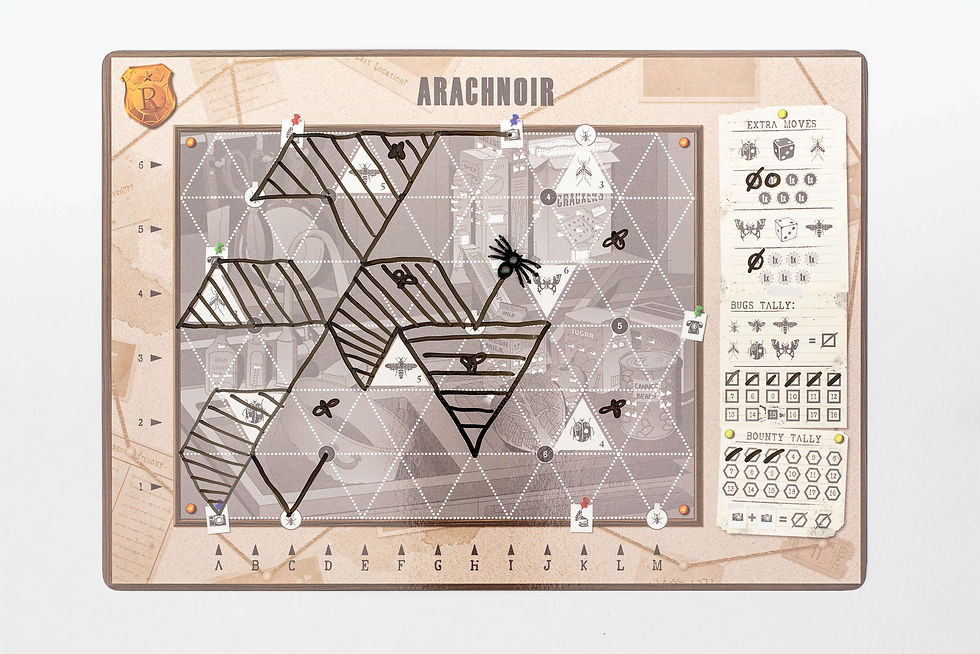
Lesson #7: (Good) Games are not made in isolation
Having settled on the rough plan for the game, version 1 of the prototype was tabled for playtesting with The Thursday Playtesters in March of 2020. It was from there that a huge number of game-changing rules were introduced. Daryl, the other co-designer of Arachnoir, maintained the core structure of the game map, while adding bug sizes and competitive objectives with diminishing rewards. These two changes, I think, became the new heart of Arachnoir’s gameplay.
With the concept of bug sizes that require specific sized webs to catch them, the game became much more strategic, requiring players to plan their moves carefully so as not to lose scoring opportunities. With the addition of competitive goals, player interaction now went beyond the placement of new flies in other players’ boards (a mechanic that promoted keeping an eye on other spiders’ locations) to include a tense, competitive element. These changes laid the groundwork for me to develop a host of other refinements and changes, such as bugs with unique catching criteria. One of these bugs that I created later was the grasshopper which (true to its roots in the Spider: Rite of the Shrouded Moon game) attempts to flee from your web when you try to catch it, necessitating a carefully planned trap set up at the escape route.
I had also been inspired by Daryl’s recent game at that time, Wok and Roll, and incorporated the use of checkboxes to record power ups and usage. These naturally lent themselves to a system of bonus moves and bonus points as rewards for successfully pursuing side objectives and completing difficult tasks. Balancing out these bonuses subsequently became the focus of the later part of the game’s development. Many more ideas were developed with other people, such as standalone puzzles based on the Arachnoir webbing mechanic, as well as solo game modes (wonderfully and rigorously tested by one of our playtesters, Gary Yeh). While these eventually fell beyond the scope of what we were confident of publishing right now, I hope to be able to release them in a future edition.
When designing games, it is important to be open to suggestions and changes, and more importantly, open to accept honest criticism.
Arachnoir would have been left at its very raw version 1 state if I had not brought it out to be playtested and critiqued. Throughout its development journey many of its mechanics might have been left unbalanced if we had not stress-tested them over and over. If we had not received feedback through the lens of many different people, we would not have realised that some players needed a shape reference card in order to play the game smoothly. Arachnoir is what it is today only through the combined input of many people.
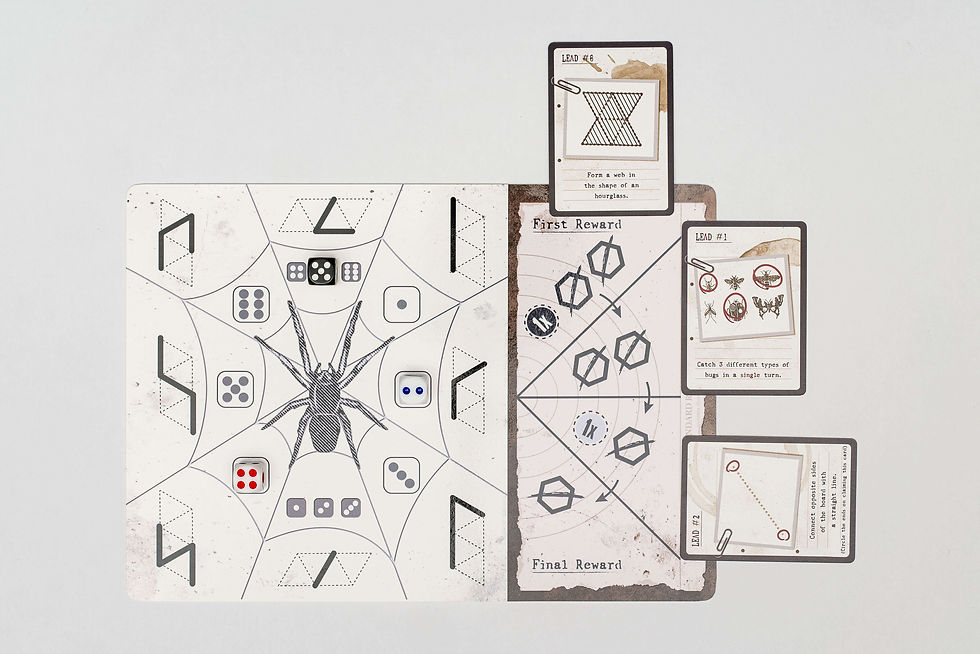
Lesson #8: The Importance of Blind Playtests
One of the mistakes I almost made was to try to push out the game into the market without running it through blind playtests. It was late into the development cycle and I was pretty confident about the game and the rulebook. Fortunately, my wife found a group of playtesters to run the game “blind”, and the mistakes and confusion in some parts of the rulebook were rather embarrassing, to say the least. The blind playtesters also suggested changes where the iconography and writing could be further streamlined.
As a game designer that has worked on the game for many months, many parts of the game come naturally to me (and to the regular playtesters too), such as sequence of moves, how to fit the shapes, and what actions were legal/illegal in certain scenarios. It was this familiarity that made me write a rulebook that was easily understood by me, but not necessarily so for a new player picking up the game for the first time.
The input from the blind playtest group was invaluable to making the rulebook more user-friendly.
Don’t ignore blind playtesting!
Remember, when your game goes out there, you won’t be able to stand besides every gaming group, instructing them and clarifying the rules of your game!
To Wrap (or perhaps, to Web?) it all up
Arachnoir’s design journey has been an insightful one for me, and it is very much the game it is today because of the help of many people. I hope the lessons that I have learnt and shared here will be useful to any would-be aspiring board game designers out there too!

Comentarios